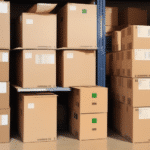How to Create an Effective Packing List for Your Supply Chain
Managing the supply chain can be incredibly complex and requires careful planning and execution. One critical component of a successful supply chain is an effective packing list. The packing list serves as a detailed inventory of the items being shipped and provides critical information to the supply chain team. In this article, we will explore the importance of an effective packing list, understand its components, and provide tips and best practices for streamlining your packing list creation process.
The Importance of an Effective Packing List for Your Supply Chain
An effective packing list is essential for the smooth operation of a supply chain. It helps the team know what items are being shipped, where they are going, and any special instructions or handling requirements. It serves as a communication tool between different departments, ensuring that everyone is on the same page. According to a Supply Chain Brain report, accurate packing lists can reduce shipping errors by up to 30%, significantly improving overall efficiency.
An accurate and comprehensive packing list can help reduce delays, avoid errors, and improve efficiency. Without a packing list, the supply chain team would be facing an uphill battle, guessing what items are in transit, and where they are headed.
In addition to the benefits mentioned above, an effective packing list can also help with inventory management. By keeping track of what items are being shipped and where they are going, the team can better manage their inventory levels and avoid overstocking or understocking. This can lead to cost savings and improved customer satisfaction, as orders can be fulfilled more quickly and accurately. Furthermore, a packing list can also serve as a record of what was shipped, which can be useful in case of disputes or returns. Overall, investing in an effective packing list can have a significant impact on the success of your supply chain operations.
Understanding the Components of a Packing List
A packing list should include specific details about the shipment, such as the number of items, weight, and dimensions. It should also include information about the recipient, including their address and contact information. Additionally, a packing list may include details about the items being shipped, such as a description, part number, or SKU. Special handling instructions or any regulatory compliance requirements should also be included on the packing list.
Another important component of a packing list is the carrier information. This includes the name of the carrier, the tracking number, and the expected delivery date. According to the Inbound Logistics, including carrier information enhances the traceability of shipments, allowing for real-time tracking and timely deliveries.
In addition, a packing list may also include any additional documents that are required for the shipment, such as customs forms or invoices. By including all of these components on the packing list, you can ensure that the shipment is properly documented and that it arrives at its destination without any issues.
Tips for Creating a Comprehensive and Accurate Packing List
When creating a packing list, it's essential to be thorough and accurate. Here are some tips to ensure your packing list is comprehensive and accurate:
- Use a standardized format that works for your organization and ensures consistency in data entry and formatting.
- Double-check all details, including quantities, descriptions, and addresses, to ensure accuracy.
- Include information that is relevant to your organization, such as part numbers, batch or lot numbers, or production dates.
- If you are exporting goods, ensure you comply with all requirements for your destination country.
Another important tip for creating a comprehensive and accurate packing list is to consider the mode of transportation. For example, if you are shipping items by air, you may need to include additional information such as weight and dimensions to ensure compliance with airline regulations. Similarly, if you are shipping items by sea, you may need to include information about the container size and weight.
Finally, it's important to review and update your packing list regularly. As your organization grows and changes, your packing list may need to be revised to reflect new products, suppliers, or shipping requirements. By regularly reviewing and updating your packing list, you can ensure that it remains an effective tool for managing your organization's shipping and logistics needs.
Streamlining Your Packing List Creation Process
Creating a packing list can be time-consuming, but it's essential to get it right. Here are some tips to streamline your packing list creation process and save time:
- Use technology, such as barcoding or RFID, to automate data entry and reduce errors.
- Implement a template or standardized format to ensure consistency and reduce the time needed to create a packing list from scratch.
- Integrate your packing list creation process with your inventory management software, reducing the time needed to update information manually.
- Use a cloud-based solution that enables multiple team members to access and update packing lists for improved collaboration and real-time updates.
Another way to streamline your packing list creation process is to create a master list of items that you commonly pack. This list can be used as a starting point for future packing lists, saving you time and effort. You can also categorize items on your master list to make it easier to create specific packing lists for different types of shipments.
It's also important to review and update your packing list regularly. As your needs change, so should your packing list. By regularly reviewing and updating your list, you can ensure that you're packing everything you need and nothing you don't, saving you time and hassle in the long run.
Best Practices for Organizing and Formatting Your Packing List
Organizing and formatting your packing list effectively can help improve its readability and ensure that critical details are easy to find. Here are some best practices for organizing and formatting your packing list:
- Include a header that clearly identifies the packing list and shipment.
- Use a clear and concise format that minimizes clutter and ensures that vital details are easy to find.
- Use bold or italics to highlight important information, such as special instructions or key item details.
- Include a legend or key to explain any abbreviations or symbols used on the packing list.
- Number each item being shipped to avoid errors and reduce confusion.
Utilizing Technology to Improve Your Packing List Management
Technology can be a powerful tool to improve your packing list management. Here are some ways to utilize technology to enhance your packing list management:
- Automate data entry using barcode scanning or RFID technology.
- Integrate packing list creation and management with your inventory management software for real-time updates and inventory control.
- Use a cloud-based solution that enables multiple team members to access and update packing lists for improved collaboration and real-time updates.
- Implement analytics software to track performance metrics and identify areas for improvement in your packing list creation and management processes.
Common Mistakes to Avoid When Creating a Packing List
To ensure the accuracy and effectiveness of your packing list, it's essential to avoid common mistakes. Here are some mistakes to avoid:
- Mislabeling shipped items or using ambiguous descriptions that can lead to confusion or errors.
- Omitting critical information, such as special handling requirements or regulatory compliance requirements.
- Skipping the numbering of items on the packing list, leading to errors in tracking or inventory control.
- Using the wrong template or format for the packing list, leading to inconsistencies or incorrect formatting.
Ensuring Compliance with Industry Standards and Regulations
The packing list must comply with industry standards and regulations to ensure the safe and secure shipment of items. Key areas of focus for compliance include hazardous materials, food safety, and export/import regulations. According to the Health and Safety Executive (HSE), staying informed about changes to regulations and ensuring your packing list meets these requirements can prevent delays or noncompliance issues.
How an Effective Packing List Can Improve Supply Chain Efficiency
An effective packing list is a critical component of an efficient and well-oiled supply chain. By providing accurate and comprehensive information about shipments, a packing list can help reduce delays, avoid errors, and improve collaboration between different departments. According to a study by McKinsey & Company, optimized packing processes can enhance supply chain efficiency by up to 20%, leading to significant cost savings and faster delivery times.
With an effective packing list process in place, your supply chain team can quickly and efficiently track items, reduce inventory shortages, and optimize resource utilization.
The Role of Communication in Effective Packing List Creation
Effective communication is critical when creating a packing list. The supply chain team must work together to gather and verify details, and departmental collaboration is essential for success. In addition, communicating with customers and vendors can also play a crucial role in the packing list creation process. By communicating effectively, you can gather information about any special requirements, ensure that shipments are correctly labeled and packaged, and avoid issues with noncompliance or delays.
Evaluating and Improving Your Packing List Over Time
Continuous improvement is an essential part of any successful supply chain. It's essential to evaluate your packing list creation and management processes regularly to identify areas for improvement. Use analytics software to track performance metrics, gather feedback from team members, and assess compliance with industry regulations. Regularly revising your processes and incorporating feedback can help you optimize your packing list creation and management and ultimately, improve your supply chain efficiency.
Incorporating Sustainability into Your Packing List Strategy
Sustainability is an increasingly critical consideration for organizations of all sizes. Incorporating sustainability into your packing list strategy can have a positive impact on the environment, reduce waste, and cut costs. Here are some ways to incorporate sustainability into your packing list strategy:
- Use eco-friendly packaging materials that reduce waste and are recyclable or biodegradable.
- Minimize packaging and use alternative packaging options, such as reusable totes or crates.
- Optimize shipping routes to reduce carbon emissions and transportation costs.
- Use technology, such as RFID, to track shipments and reduce the need for paper-based processes.
According to the Ellen MacArthur Foundation, sustainable packing practices not only benefit the environment but also enhance brand reputation and customer loyalty.
The Benefits of Outsourcing Your Packing List Management
Outsourcing your packing list management can have several benefits, including reducing costs, improving accuracy, and enhancing compliance. By outsourcing to a third-party provider, you can leverage their expertise, technology, and experience to improve your packing list creation and management processes. Outsourcing can also free up your internal resources to focus on other areas of your supply chain or core business operations.
Additionally, partnering with specialized providers can ensure that your packing list processes are up-to-date with the latest industry standards and regulations, providing an added layer of compliance assurance.
Examples of Effective Packing Lists in Action
Examples of effective packing lists can vary depending on the industry and type of items being shipped. However, some examples of effective packing lists in action include:
- A pharmaceutical company shipping a new drug to clinical trial sites, ensuring each package meets strict regulatory standards.
- A manufacturer shipping parts to an assembly plant, using standardized packing lists to streamline assembly line processes.
- A retailer shipping goods to distribution centers or stores, utilizing optimized packing lists to manage high-volume inventory efficiently.
Conclusion
An effective packing list is a critical component of a successful supply chain. It serves as a detailed inventory of the items being shipped and provides critical information to the supply chain team. By understanding the components of a packing list and following best practices for creation and management, you can improve efficiency, reduce errors, and enhance compliance. Incorporating sustainability into your packing list strategy and outsourcing your packing list management can also have significant benefits. By continuously evaluating and improving your packing list creation and management processes, you can optimize your supply chain's efficiency and achieve your organizational goals.




















